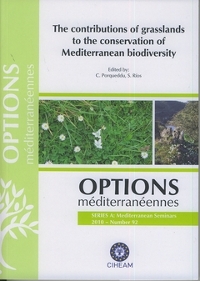| Article précédent | p. 161-164 | Article suivant |
Ecophysiological responses of two ecotypes of Dactylis glomerata L. under water-deficit conditions
Development of improved water-saving varieties is a high priority in forage grass breeding programs especially if the climate change predictions for the Mediterranean region become true. In this experiment the adaptation responses of two ecotypes of Dactylis glomerata L., one from a fir forest and the other from an adjacent open grassland, to water-deficit conditions were studied. Plants of these ecotypes were planted into pots and subjected during the growing season to two water supplies: (i) well-watered conditions; and (ii) rainfed conditions. Leaf water potential, relative water content, assimilation rate, stomatal conductance, transpiration rate and water use efficiency were assessed at seven-day intervals during the experimental period. Both water regime and ecotype were found to play some role in the ecophysiological responses of D. glomerata to water shortage. Under the conditions of moderate water stress of the present experiment, the forest ecotype showed a drought resistance behaviour, maintaining its photosynthetic efficiency. On the contrary the grassland ecotype showed a drought avoidance behaviour, limiting transpirational loss through stomatal closure, negatively affecting its photosynthetic capacity.
Le développement de variétés nécessitant moins d'apports en eau est une priorité des programmes de recherche sur les céréales, d'autant plus si les prédictions de changements climatiques sur la région méditerranéenne s'avèrent exactes. Dans cette étude, les réponses adaptatives à un déficit en eau, de deux écotypes de Dactylis glomerata L., l'un provenant d'une forêt de sapins, et le second d'une prairie adjacente, sont étudiées. Les plants sont mis en pots et lors de la période de croissance, l'apport en eau est soit abondant, soit analogue à celui fourni par les eaux de pluie. Le potentiel hydrique foliaire, le taux d'humidité relative, le taux d'assimilation, la conductance stomatique, le taux de transpiration, et l'efficacité de l'utilisation de l'eau sont mesurés à 7 jours d'intervalle au cours de la période d'étude. Le régime d'alimentation en eau et l'écotype ont tous les deux des effets sur les réponses écophysiologiques de D. glomerata sur la réduction de l'apport en eau. Sous les conditions modérées de stress hydrique proposées par cette étude, l'écotype forestier présente une résistance à la sécheresse permettant de maintenir l'efficacité de la photosynthèse. Par contre, l'écotype de prairie réagit à la sécheresse en limitant les pertes liées à la transpiration foliaire par une fermeture des stomates, réduisant ainsi l'efficacité de la photosynthèse.
- [ Afficher ]
- [ Télécharger ]
- [ Exporter la citation ]
Vous pouvez télécharger la citation au format :
- [ Imprimer ]
-
Mots-clés
DACTYLIS GLOMERATA, EFFICIENCE D'UTILISATION DE L'EAU, PHYSIOLOGIE VEGETALE, POTENTIEL HYDRIQUE FOLIAIRE, REPONSE DE LA PLANTE, SECHERESSE, STOMATE, TRANSPIRATIONCiter cet article
Kostopoulou P., Karatassiou M., Abraham E.M., Parissi Z.M., Kyriazopoulos A.P., Kapsali E. Ecophysiological responses of two ecotypes of Dactylis glomerata L. under water-deficit conditions. In : Porqueddu C. (ed.), Ríos S. (ed.). The contributions of grasslands to the conservation of Mediterranean biodiversity. Zaragoza : CIHEAM / CIBIO / FAO / SEEP, 2010. p. 161-164. (Options Méditerranéennes : Série A. Séminaires Méditerranéens; n. 92). 13. Meeting of the Sub-Network on Mediterranean Forage Resources of the FAO-CIHEAM International Network for the Research and Development of Pasture and Forage Crops, 2010/04/07-10, Alicante (Spain). http://om.ciheam.org/om/pdf/a92/00801236.pdf



